Christmas and holiday season facts for kids
Quick facts for kids 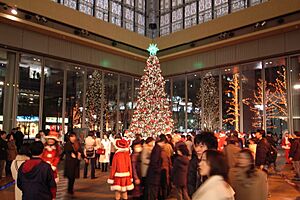
Christmas tree in Japan. Christmas is celebrated by an increasing number of non-Christians around the world.
|
|
| Also called |
|
|---|---|
| Significance | Christian and secular festive season |
| Observances |
|
| Begins | Varies, generally late November or early December |
| Ends | Commonly after New Year's Day (January 1), or Epiphany (January 6) |
| Related to |
|
The Christmas season is a special time of year. It is also known as the holiday season or the holidays. This period usually runs from late November or December to early January. It includes important days like Christmas Day and New Year's Day. Many people celebrate by giving gifts, which makes it a very busy time for stores. You might see beautiful Christmas window displays and Christmas lights during this festive period.
In Western Christianity, the Christmas season is traditionally called Christmastide. This period lasts from December 25th (Christmas Day) to January 5th (the night before Epiphany). These are often called the Twelve Days of Christmas. In Italy, the holiday season starts on December 8th with the Feast of the Immaculate Conception. This is when many families put up their Christmas tree. The season ends on January 6th with the Epiphany. Before Christmas Day, many Christians observe Advent. This is a time of preparation that begins four Sundays before Christmas. Many people use an Advent calendar to count down the days until Christmas.
Over time, especially in the United States, the Christmas holiday became very popular. It also became important for businesses. Because of this, the term "holiday season" became more common. This term includes other celebrations like the Jewish holiday of Hanukkah and the African American holiday of Kwanzaa. This helps everyone feel included during this festive time of year. While "holiday season" is popular in North America, in places like the United Kingdom, people usually refer to it as the "Christmas–New Year period."
Contents
A Look Back: History of the Holiday Season
Ancient Winter Celebrations
The Winter Solstice: A Time of Light
Long ago, even before written history, people noticed the winter solstice. This is the shortest day of the year in the Northern Hemisphere, happening in late December. Ancient sites like Stonehenge in England and Newgrange in Ireland show this. These huge stone structures were built to line up with the sunrise or sunset on the winter solstice. This suggests it was a very important time for early cultures.
Roman Saturnalia: A Festival of Fun
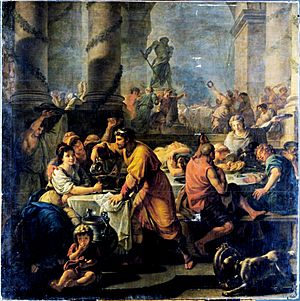
The Saturnalia was an ancient Roman festival. It honored Saturn, the god of time. This festival took place from December 17th to December 23rd. People celebrated with sacrifices, public feasts, and private gift-giving. It was a time of great joy and a carnival-like atmosphere. During Saturnalia, many normal social rules were relaxed. For example, gambling was allowed, and sometimes masters even served their household workers. This festival brought people together and created a strong sense of community. The poet Catullus called it "the best of days."
The Birth of Christmas Celebrations
Celebrating Jesus' Birth
The idea of celebrating Jesus' birth on December 25th appeared in the early 3rd century. Some early Christian churches in the East celebrated Jesus' birth and baptism on January 8th. Churches in the West celebrated the birth on December 25th. This date might have been influenced by the Winter solstice. By the late 4th century, both dates were part of the church calendars.
Christmastide: The Traditional Christmas Season
In Christian traditions, the Christmas season begins on Christmas Day, December 25th. For some churches, it continues until Twelfth Night (January 5th) or Epiphany (January 6th). Other churches celebrate it until the Feast of the Baptism of the Lord. This usually falls on the Sunday after Epiphany. This period is often called the Twelve Days of Christmas. Before this season, Christians observe Advent, a time of preparation.
How the Holiday Season Grew
From Religious to Widespread Celebration
Over the 19th and 20th centuries, Christmas became more than just a religious holiday. It grew into a major cultural event. Many new traditions and symbols appeared. These include Santa Claus, the Nutcracker, and Rudolph the Red-Nosed Reindeer. Public celebrations became common, like Christmas tree lighting ceremonies and Santa Claus parades. People started decorating their homes with Christmas decorations and singing Christmas carols. Many also enjoy Christmas markets and special Christmas dinners.
Expanding the "Holiday Season"
In the United States, the "holiday season" has expanded to include more than just Christmas. It often begins around Thanksgiving and includes other holidays. These can be Hanukkah (a Jewish holiday) and Kwanzaa (an African American cultural holiday). This broader term helps to include different traditions and celebrations that happen around the same time of year. This expansion started in the 1920s when department stores began using Thanksgiving parades to promote Christmas shopping.
Holiday Greetings Around the World
People use many different greetings during the holiday season. These greetings help spread goodwill to family, friends, and even strangers.
"Merry Christmas" and "Happy Christmas"
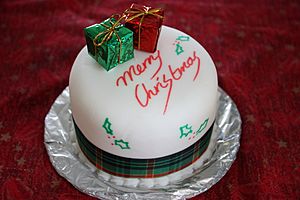
"Merry Christmas" and "Happy Christmas" are the traditional greetings in English-speaking countries. People start using them a few weeks before December 25th.
- "Merry Christmas" is the most common greeting. The word "merry" means joyful or happy.
- "Happy Christmas" is another greeting, often used in Great Britain and Ireland.
- "Merry Xmas" is sometimes written, with "X" standing for "Christ."
These greetings are popular even in countries where most people are not Christian, like China and Japan. This shows how widely Christmas culture has spread.
History of the Phrase
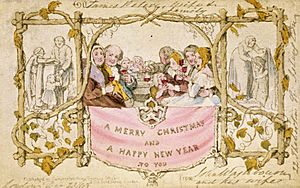
The word "merry" used to mean simply "pleasant." The first known Christmas greeting was in 1534. The phrase "Merry Christmas and a happy new year" appeared in a letter in 1699. This same phrase is in the carol "We Wish You a Merry Christmas." It also appeared on the very first commercial Christmas card in 1843.
In 1843, Charles Dickens' famous book A Christmas Carol was published. This book helped make "Merry Christmas" very popular. In the story, the grumpy Ebenezer Scrooge learns to embrace the holiday spirit. He then joyfully exclaims, "A merry Christmas to everybody!" This helped the phrase become a beloved part of the holiday season.
"Happy Holidays" and "Season's Greetings"
In North America, "Happy Holidays" has become a common greeting. It is used in stores, on greeting cards, and in public places. This greeting is usually heard between American Thanksgiving and New Year's Day. It has been used as a Christmas greeting in the U.S. for over 100 years.
"Season's Greetings" is another common phrase. It is often seen on greeting cards and in advertisements. This greeting became popular in the late 19th century. It offers a general message of goodwill for the entire festive period.
Holiday Shopping and Gift Giving
The Busiest Time for Stores
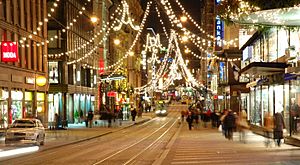
Giving gifts is a big part of the Christmas and holiday season. This makes it a very busy time for stores. This "holiday shopping season" includes a rush of buying before Christmas. It also includes sales at the end of the season, often called "January sales." Many people use gift cards they received as presents during these sales.
Shopping in North America
In the United States, the holiday season is very important for shopping. It traditionally starts the day after American Thanksgiving. This day is known as Black Friday. It is often considered the busiest shopping day of the year. However, the last Saturday before Christmas, called Super Saturday, can also be extremely busy.
For online shopping, the first Monday after US Thanksgiving is called Cyber Monday. It is a big day for online deals. Other important online shopping days include Green Monday (the second Monday in December) and Free Shipping Day. Free Shipping Day is the last day you can order gifts online with standard shipping and have them arrive before Christmas Eve.
Christmas Creep: Starting Early
"Christmas creep" is a term for when stores start selling Christmas items earlier and earlier. You might see Christmas decorations and gifts in stores even before Halloween! Retailers do this to get a head start on the busy holiday shopping season. In the UK, this period is called the "golden quarter" (October to December) because stores hope to make the most profit then.
Shopping Traditions in Europe
In the UK and Ireland, Christmas shopping usually starts in mid-November. This is often when the Christmas lights are turned on in towns. In the Netherlands and Belgium, there's a double holiday season. It starts with the arrival of Sinterklaas (Saint Nicholas) in mid-November, with gifts given on December 5th or 6th. Christmas celebrations then follow.
In France and Italy, special "January sales" begin after New Year's Day. These sales are regulated by law and last for a few weeks. Germany also has winter sales, though the rules have changed over time. In Sweden, the "Mellandagsrea" (between days sell off) starts after Christmas, similar to Black Friday but lasting longer.
Holiday Shopping in Asia
In the Philippines, people hang parols (star-shaped lanterns) and light up their homes. Special dawn masses called Simbang Gabi begin on December 16th and last until Christmas Eve. Hong Kong celebrates with many seasonal activities, including the Winterfest party and beautiful light displays on buildings.
South Korea, where about 30% of the population is Christian, also celebrates Christmas as a public holiday. In Singapore, Christmas is a public holiday, and the famous Orchard Road glitters with lights and decorations for six weeks. Indonesia, a country with many different faiths, also celebrates Christmas as a public holiday. They even hold a National Christmas Celebration each year in different cities.
The Week Between Christmas and New Year
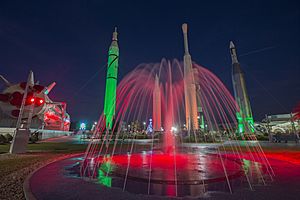
The week between Christmas Day and New Year's Day is a unique time. It's sometimes called "Betwixtmas" or "Dead Week." Many people are off from work or school, and routines are often paused. This can sometimes make it feel like time loses its meaning, and you might not be sure "what day it is"! It's a period for relaxing, reflecting, and enjoying the festive break.
Images for kids
See also
 In Spanish: Temporada navideña para niños
In Spanish: Temporada navideña para niños








